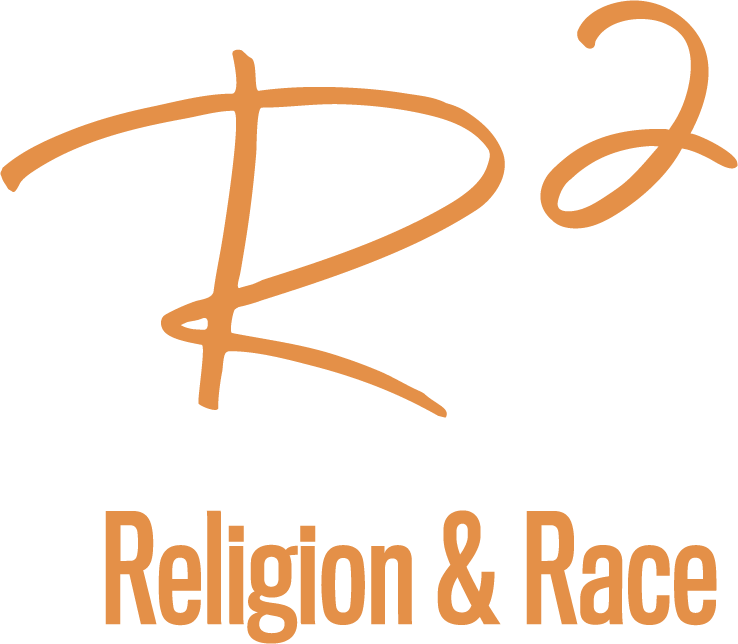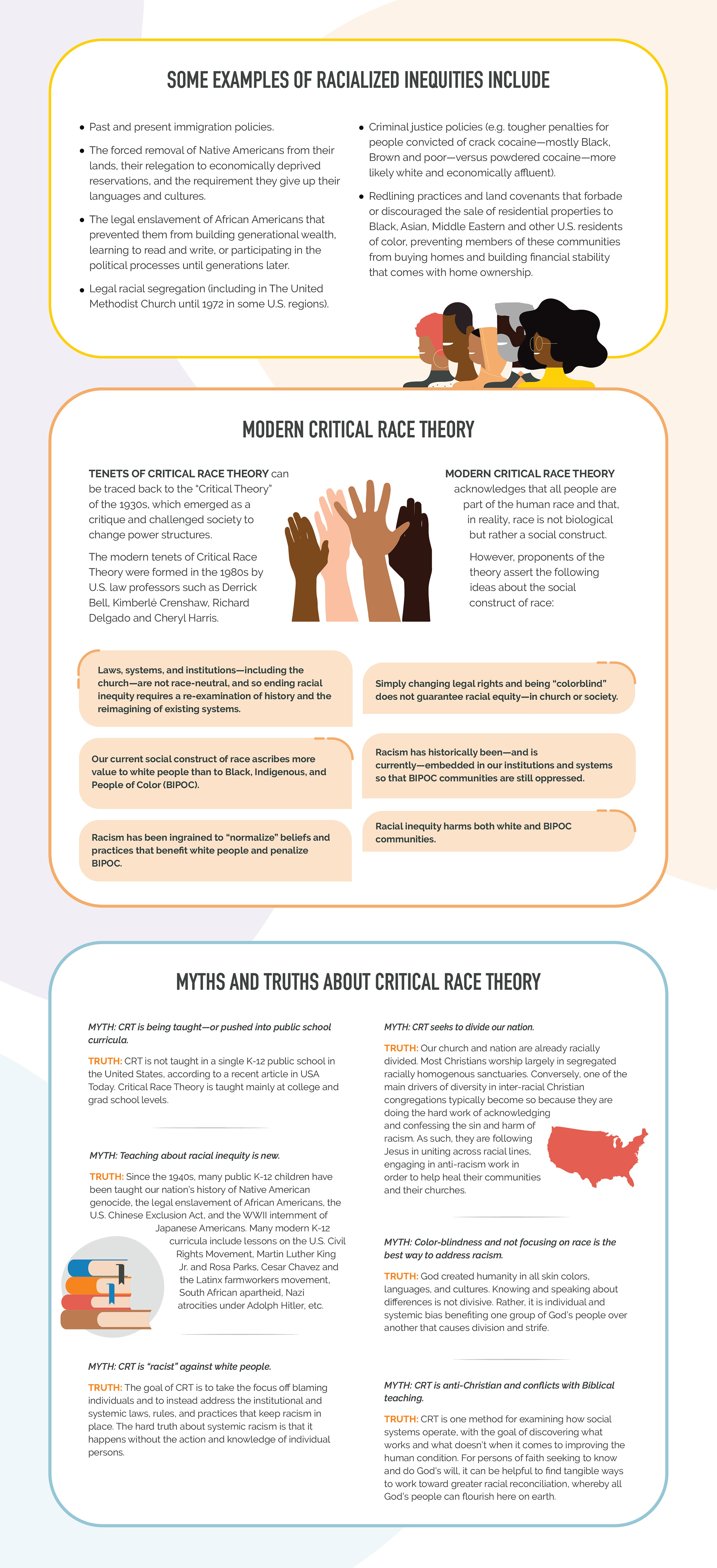What is Critical Race Theory and What Christians Should Know
*This resource was awarded 3rd place in the “Electronic Special Publication” category by the United Methodist Association of Communicators in 2022.
Critical Race Theory (CRT) examines how laws in the United States have built and supported racial inequities. It is an ideological framework that names race as a social construct and asserts racialized inequities in society are fostered by historic and current systemic, institutional, and legal policies and practices.
GCORR REAL TALK
We invite you to view this video to learn more about Critical Race Theory. Garlinda Burton speaks with guests, Dr. Karla McKanders, Dr. Cristian De La Rosa, and Dr. Miguel De La Torre.
Critical Race Theory Infographic Series
At the bottom of this page you’ll find a full readout of the text it contains. This helps aid accessibility, particular for those using screen-reading software.
Christian Voices on Critical Race Theory
“Critical Race Theory understands racism not as biological, but as a social construct designed consciously or unconsciously to further the power, profit and privilege of white people. These constructs are naturalized and legitimized through social structures and institutions.”
—The Rev. Dr. Miguel De La Torre, Southern Baptist clergyperson, professor of social ethics and Latinx studies at Iliff School of Theologyn in Denver, CO and founding editor of The Journal of Race, Ethnicity, and Religion
“Critical Race Theory can provide resources to think about the ways the sin of racism permeates the fabric of our society in all its dimensions. Where there is suffering and inequality, Christians are called to mourn, repent of the ways we contribute to the problem, and join together to challenge the broader structures that produce injustice.”
—The Rev. Dr. Hyemin Na, assistant professor of religion media and culture at Drew Theological School, Madison, NJ
“[Critical Race Theory] shows us how all of us—white, Black, Asian, Latinx, multiracial, etc.—are caught up in a system that goes beyond any one person’s attitudes and actions. I think that Paul understands this when he asks the Ephesians to put on God’s armor and fight against rules, authorities, forces of cosmic darkness, and spiritual powers of evil (Ephesians 6:12), rather than fighting against ‘human enemies.’ To fight racism, I do not fight white people, I fight racism with other white people who want to fight racism.””
—Dr. Elizabeth Corrie, associate professor in the practice of youth education and peacebuilding and director of the religious education program, Candler School of Theology at Emory University in Atlanta, GA
“While Critical Race Theory fails to recognize the root cause of racism (human sin), Critical Race Theorists have done a good job paying attention to the ways in which racism manifests itself in Western societies….[It] creates a greater urgency for those of us in the Church to do a better job at paying attention to these things and processing them within a Biblical framework.”
—Dr. Kelly Hamren, assistant professor of English at Liberty University in Lynchburg, VA
Read More Christian Perspectives
“Critical race theory is a gift to Christians.” Editors in The Christian Century, June 28, 2021.
”What Christians get wrong about Critical Race Theory (Part 1).” Nathan Luis Cartagena, in Faithfully Magazine, 2020.
“I Agree: Critical Race Theory is Indeed Incompatible with Southern Baptist Convention’s ‘Faith and Message’.” Miguel De La Torre, in Religious Dispatches, Dec. 14, 2020.
“Unpacking Critical Race Theory (CRT) for Christians: Toward A Better Theology of Race.” Kelly Hamren, in P2C-Students, Feb. 16, 2021.
“Critical Race Theory: Common Misconceptions” Khiara M. Bridges on YouTube, June 24, 2021.
How White Christians Can Learn from History and Tackle Racism
Educate yourself and act locally. For example, if you read an article about voting rights violations against People of Color in your community, ask how your church can help.
Learn from authentic relationships. Establish relationships—beyond charitable giving—with a Black, Indigenous, People of Color (BIPOC) congregation or a campus ministry, through which you can listen and learn about their experiences with systemic racism.
Discover the historic and current BIPOC contributions and stories in your denomination. For heritage and homecoming celebrations, highlight the good stories as well as the difficult ones about the people who built the denomination and pushed for equality for all persons in your faith communities.
Don’t run from racial justice conversations. Our battle as Christians is not against one another, but against sin and injustice. Working together to end racism requires white people to work alongside BIPOC communities to ensure our congregational life, our worship and evangelism, our outreach and mission, and our living in the world beyond the church are freed from systemic racism.
Here you’ll find a full readout of the text contained in the infographic above. This helps aid accessibility, particular for those using screen-reading software.
Some Examples of Racialized Inequities Include:
Past and present immigration policies.
The forced removal of Native Americans from their lands, their relegation to economically deprived reservations, and the requirement they give up their languages and cultures.
The legal enslavement of African Americans that prevented them from building generational wealth, learning to read and write, or participating in the political processes until generations later.
Legal racial segregation (including in the United Methodist Church until 1972 in some U.S. regions).
Criminal justice policies (e.g. tougher penalties for people convicted of crack cocaine - mostly Black, Brown, and poor - versus powdered cocaine - more likely white and economically affluent).
Redlining practices and land covenants that forbade or discouraged the sale of residential properties to Black, Asian, Middle Eastern, and other U.S. residents of color, preventing members of these communities from buying homes and building financial stability that comes with home ownership.
Modern Critical Race Theory
Tenets of Critical Race Theory can be traced back to the “Critical Theory” of the 1930s, which emerged as a critique and challenged society to change power structures. The modern tenets of Critical Race Theory were formed in the 1980s by U.S. law professors such as Derrick Bell, Kimberlé Crenshaw, Richard Delgado, and Cheryl Harris.
Modern Critical Race Theory acknowledges that all people are part of the human race and that, in reality, race is not biological but rather a social construct. However, proponents of the theory assert the following ideas about the social construct of race:
Laws, systems, and institutions - including the church - are not race-neutral, and so ending racial inequity requires a re-examination of history and the reimagining of existing systems.
Simply changing legal rights and being “colorblind” does not guarantee racial equity - in church or society.
Our current social construct of race ascribes more value to white people than to Black, Indigenous, and People of Color (BIPOC).
Racism has historically been - and is currently - embedded in our institutions and systems so that BIPOC communities are still oppressed.
Racism has been ingrained to “normalize” beliefs and practices that benefit white people and penalize BIPOC.
Racial inequity harms both white and BIPOC communities.
Myths and Truths About Critical Race Theory
MYTH: CRT is being taught - or pushed into public school curricula.
TRUTH: CRT is not taught in a single K-12 public school in the United States, according to a recent article in USA Today. Critical Race Theory is taught mainly at college and grad school levels.
MYTH: Teaching about racial inequity is new.
TRUTH: Since the 1940s, many public K-12 children have been taught our nation’s history of Native American genocide, the legal enslavement of African Americans, the U.S. Chinese Exclusion Act, and the WWII internment of Japanese Americans. Many modern K-12 curricula include lessons on the U.S. Civil Rights Movement, Martin Luther King Jr. and Rosa Parks, Cesar Chavez and the Latinx farmworkers movement, South African apartheid, Nazi atrocities under Adolph Hitler, etc.
MYTH: CRT is “racist” against white people.
TRUTH: The goal of CRT is to take the focus off blaming individuals and to instead address the institutional and systemic laws, rules, and practices that keep racism in place. The hard truth about systemic racism is that it happens without the action and knowledge of individual persons.
MYTH: CRT seeks to divide our nation.
TRUTH: Our church and nation are already racially divided. Most Christians worship largely in segregated racially homogeneous sanctuaries. Conversely, one of the main drivers of diversity in inter-racial Christian congregations typically become so because they are doing the hard work of acknowledging and confessing the sin and harm of racism. As such, they are following Jesus in uniting across racial lines, engaging in anti-racism work in order to help heal their communities and their churches.
MYTH: Color-blindness and not focusing on race is the best way to address racism.
TRUTH: God created humanity in all skin colors, languages, and cultures. Knowing and speaking about differences is not divisive. Rather, it is individual and system bias benefiting one group of God’s people over another that causes division and strife.
MYTH: CRT is anti-Christian and conflicts with Biblical teaching.
TRUTH: CRT is one method for examining how social systems operate, with the goal of discovering what works and what doesn’t when it comes to improving the human condition. For persons of faith seeking to know and do God’s will, it can be helpful to find tangible ways to work toward greater racial reconciliation, whereby all God’s people can flourish here on earth.

